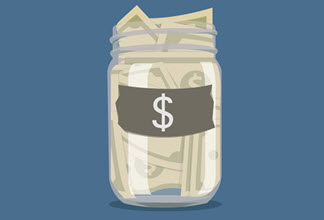How Much Can I Contribute to My TFSA?
Published on January 8, 2021
minute read
Share:
Last updated: December 2025
Tax-Free Savings Account (TFSA) contribution room accumulates every year, even if you haven't opened a TFSA. If you are a Canadian resident, your contribution room begins accumulating from 2009 or from the year in which you turned 18. So, if you open a new TFSA in 2026 and have never contributed to a TFSA elsewhere, you would have total available contribution room of $109,000 if you were 18 or older in 2009.
If at any time in the calendar year you are 18 years of age or older and a resident of Canada with a Social Insurance Number, you are eligible to open a TFSA and contribute up to the limits below.
Note that the age of majority is 19 in Newfoundland and Labrador, New Brunswick, Nova Scotia, British Columbia, Northwest Territories, Yukon and Nunavut. Contribution room starts at age 18, however, regardless of your province of residence. So if you're a resident of Newfoundland, you can still contribute the same amount as a resident of Ontario – you just need to wait until age 19 to open the account.
| Year | Annual TFSA Contribution Limit |
| 2009 | $5,000 |
| 2010 | $5,000 |
| 2011 | $5,000 |
| 2012 | $5,000 |
| 2013 | $5,500 |
| 2014 | $5,500 |
| 2015 | $10,000 |
| 2016 | $5,500 |
| 2017 | $5,500 |
| 2018 | $5,500 |
| 2019 | $6,000 |
| 2020 | $6,000 |
| 2021 | $6,000 |
| 2022 | $6,000 |
| 2023 | $6,500 |
| 2024 | $7,000 |
| 2025 | $7,000 |
| 2026 | $7,000 |
| Total Contribution Room for 2009-2026: $109,000 |
Note that investment income earned in your TFSA and changes in the value of your investments do not affect your TFSA contribution room for current or future years.
Tracking Your TFSA Contributions
It's important to keep track of all your TFSA contributions, in the current year and in past years, so that you don't contribute above your maximum. That's important since over-contributions are subject to a monthly tax of 1 per cent for each month the excess amount stays in your TFSA. There may also be significant penalties on earnings or increases in value attributed to deliberate excess contributions.
- You can check your contribution room with CRA's My Account. Be aware that any contributions made or withdrawn from a TFSA in the prior year may not be reflected in your available current-year contribution room until after the end of February. Any transactions made in the current year will not be included.
- If you've withdrawn from your TFSA this year, a handy formula for checking what your next year's contribution room is:
Unused TFSA contribution room to date + total withdrawal made this year + next year's TFSA's contribution limit = TFSA contribution room at the beginning of next year.
- If you have multiple TFSAs, perhaps at different financial institutions, you might consider transferring in some or all of your assets to your RBC Direct Investing TFSA. This can make it easier to track your contributions and see your performance and holdings any time, at a glance.
To open your TFSA
If a TFSA is right for you, you can open your account here.
The information provided in this article is for general purposes only and does not constitute personal financial or tax advice. Please consult with your own professional advisor to discuss your specific financial and tax needs.
RBC Direct Investing Inc. and Royal Bank of Canada are separate corporate entities which are affiliated. RBC Direct Investing Inc. is a wholly owned subsidiary of Royal Bank of Canada and is a Member of the Canadian Investment Regulatory Organization and the Canadian Investor Protection Fund. Royal Bank of Canada and certain of its issuers are related to RBC Direct Investing Inc. RBC Direct Investing Inc. does not provide investment advice or recommendations regarding the purchase or sale of any securities. Investors are responsible for their own investment decisions. RBC Direct Investing is a business name used by RBC Direct Investing Inc. ® / ™ Trademark(s) of Royal Bank of Canada. RBC and Royal Bank are registered trademarks of Royal Bank of Canada. Used under licence.
© Royal Bank of Canada 2025.
Any information, opinions or views provided in this document, including hyperlinks to the RBC Direct Investing Inc. website or the websites of its affiliates or third parties, are for your general information only, and are not intended to provide legal, investment, financial, accounting, tax or other professional advice. While information presented is believed to be factual and current, its accuracy is not guaranteed and it should not be regarded as a complete analysis of the subjects discussed. All expressions of opinion reflect the judgment of the author(s) as of the date of publication and are subject to change. No endorsement of any third parties or their advice, opinions, information, products or services is expressly given or implied by RBC Direct Investing Inc. or its affiliates. You should consult with your advisor before taking any action based upon the information contained in this document.
Furthermore, the products, services and securities referred to in this publication are only available in Canada and other jurisdictions where they may be legally offered for sale. Information available on the RBC Direct Investing website is intended for access by residents of Canada only, and should not be accessed from any jurisdiction outside Canada.
Inspired Investor brings you personal stories, timely information and expert insights to empower your investment decisions. Visit About Us to find out more.










